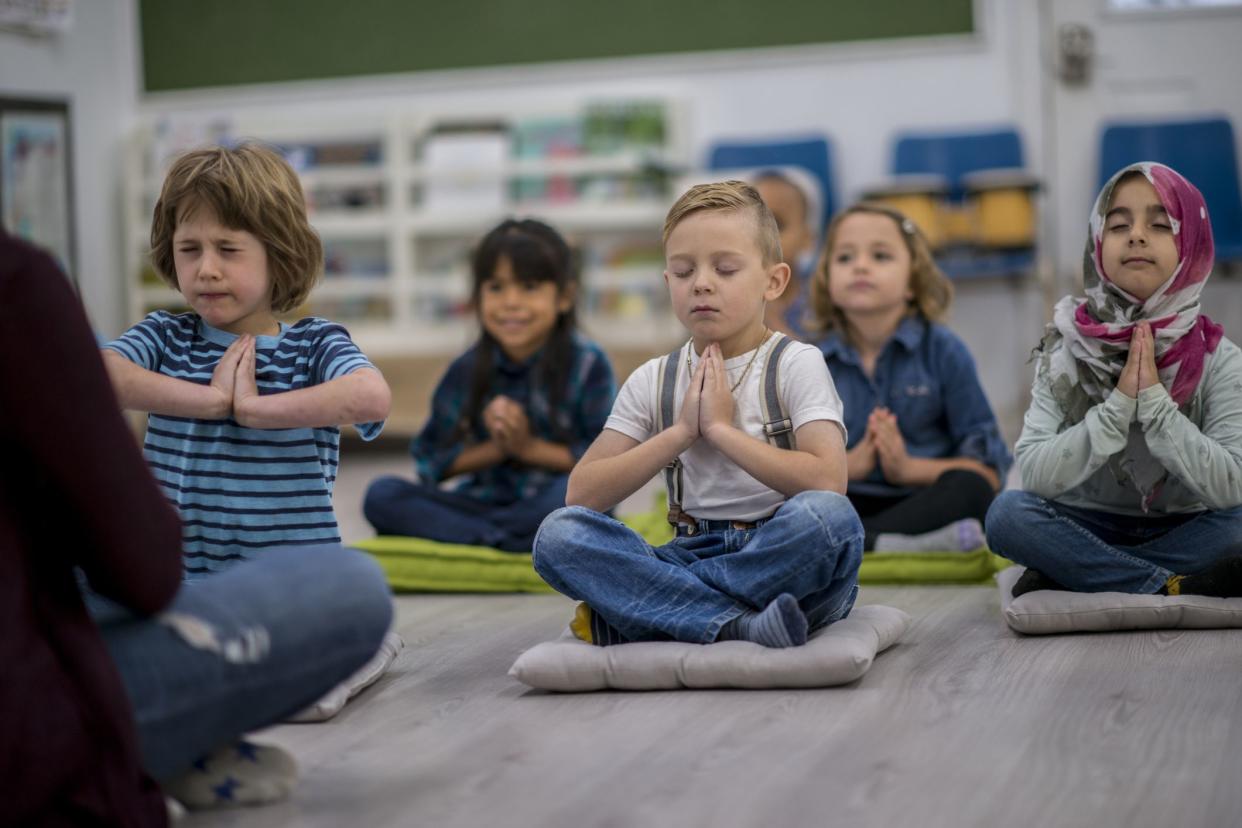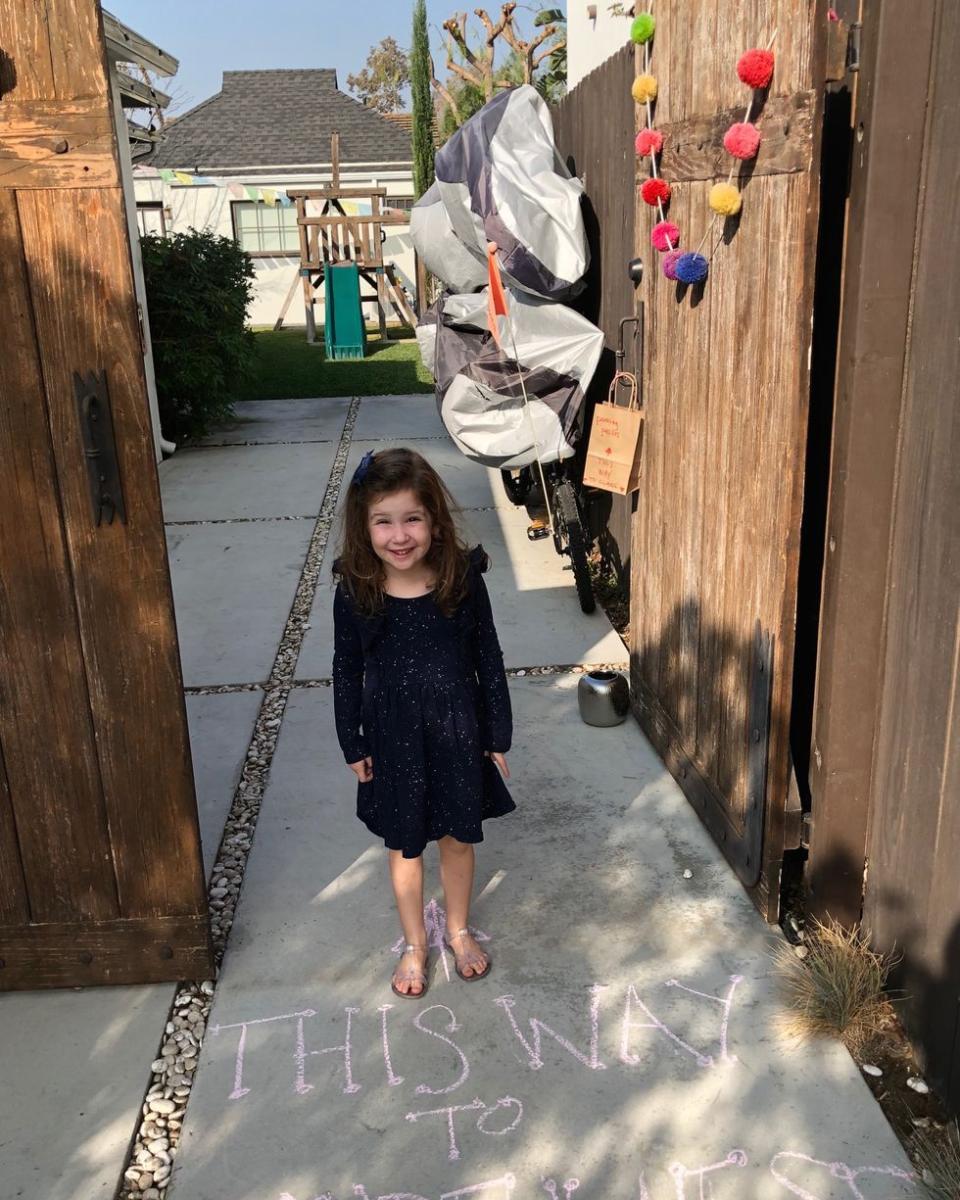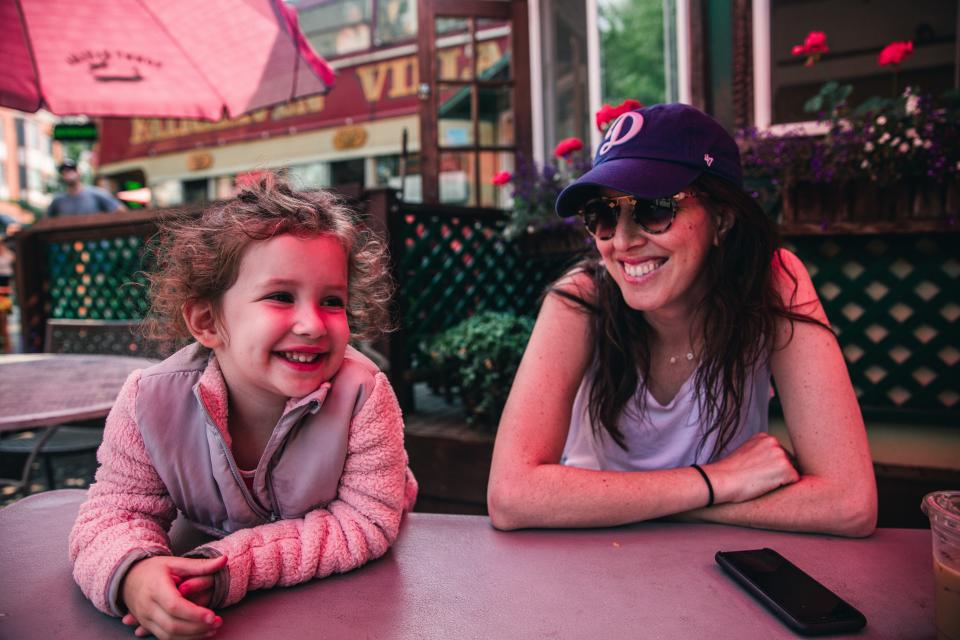Inside a Mindfulness Class for Toddlers

My daughter is three going on 13 - she’s impulsive, impatient, and often impractical in her requests. Most recently, she's decided that she deserves a lollipop for breakfast. My answer, of course, is no, which results in a tantrum. Yet 30 seconds later, she emerges from her room with a plan she’s conjured up. “I’ll eat a scrambled egg and then I can have dessert!” If only it were that easy, kid.
We live in L.A., the land of ever-evolving parenting trends. From hiring sleep trainers to get your baby snoozing through the night (guilty) to ordering organic baby food delivery (guilty, again), there’s nothing off limits in the City of Angels.
Yet when things start to feel too spiritual or touchy-feely, that’s usually my cue to unsubscribe. I don’t meditate, or even know how to really - I don't have much of a desire to be alone with my thoughts any more than I already am.
But at a recent outing with some fellow moms, a friend told me that she had taken her toddler to a mindfulness class. "It sounds totally ridiculous," she said, "but you should check it out." She said it was tough to find the time to attend weekly sessions, but even just one class helped a lot. "Especially in terms of just showing how important it is to slow down and pay attention - it was really worth it," she told me. I thought about Della’s lollipop rage, and the prospect of her learning a lesson about being patient, present, and mindful fueled me with enough curiosity to email Tinseltown’s toddler mindfulness guru, Molly D’Amecourt.
D’Amecourt, who has a bachelor’s degree in early childhood development from Loyola Marymount University and trained at UCLA’s Mindful Awareness Research Center, has been teaching mindfulness to children of all ages for the past four years. Yet even with her resumé, I was skeptical about what kind of witchcraft she was going to instill upon us.
A (really) old-school approach
The concept of mindfulness isn't anything new - for thousands of years, Buddhists have been practicing mindfulness, or the state of being tuned in to the present moment, as a necessary tool for enlightenment. Explaining that concept to the under-5 set might seem like a stretch, but it turns out my friend isn't the only one who says it changed their kid for the better. When I reached out to D'Amecourt to learn more, she cited a few success stories. "Stevie got upset and we practiced breathing," one parent had e-mailed. "It took him a minute before he was willing to take deep breaths but then he said he wanted to put something on his stomach to see if it was moving up and down and asked me if I remembered doing that with rocks in Molly’s class. You made a real impact!"
D'Amecourt, who charges $400 for her 8-week-long course for preschoolers, occasionally visits local schools to teach mindfulness to students of all ages. She says teachers tell her their classes are much quieter and noticeably more focused after she leaves. "It’s spawned teachers starting up their own practices, and a girl in high school told me she was going to propose ‘mindfulness week’ to her principal," she told me.
Those were definitely some solid endorsements, but for a more science-backed opinion, I contacted Diana Winston, director of mindfulness education at UCLA, to ask how mindfulness benefits 3- and 4-year-olds. "About 10 years ago we did a research study at UCLA on mindfulness and preschoolers," she said. "The main finding was that the children who benefited the most from it were the ones who had issues with impulse control, anger, and anxiety." While Della doesn't have those specific problems - at least not any more than any other 3-year-old - Winston added that most children could stand to learn a thing or two about mindfulness. "Basic mindfulness exercises can be fun and give kids some simple tools to regulate their attention and their emotions," she explained. Instead of throwing a tantrum when they can't figure out how a toy works or when they aren't allowed to watch a certain television show, mindfulness can help a child cope with their feelings and minimize over-the-top reactions.
Thinking out loud
The night before our trial session, I told Della I was taking her to a new class in the morning. She asked if I was taking her to a new dance class. I said, "No, it’s a thinking class!" She looked at me like I’d just told her that salad was chocolate.

We pulled up to D’Amecourt’s home at 10:25 the next morning and followed her driveway marked with chalk to the guesthouse where she holds classes. Inside the bright, clean room, poufs and cushions formed a circle on the floor around a blanket. Two metal singing bowls sat at the top of the circle near D’Amecourt’s slightly elevated throne, and a basket of goodies including raisins, two acorns, a deck of cards, and a few other props were on display.
In a smaller-than-usual group of three kids and three moms (normally, the classes have 10 to 12 attendees), D’Amecourt opened the class by rubbing a mallet against her singing bowls. My first thought was, "Oh boy. This is going to be painful."
But I was mistaken. Over the next half hour, we practiced breathing techniques, played games, and ate snacks. D'Amecourt asked the kids to close their eyes while she made the bowls sing again, then asked them to identify which bowl made which sound. I watched Della squint her eyes shut, thinking about what she was hearing.
For our last exercise, D’Amecourt handed everyone two raisins. She went around the circle and asked us to describe the shriveled brown blobs in detail, and to think about how they ended up in our palms. After that, we were instructed to put one of the raisins in our mouths and explore them with our tongues.
Though one student, a little girl slightly older than Della, had a hard time waiting to inhale her raisins, for the most part the kids sat quietly and focused intently on the task at hand: contemplating the journey these raisins took from grapevine to factory to grocery store.
D'Amecourt says that when it comes to mindfulness, most of the hard work is done by parents and kids at home - she’s just a conduit for the techniques. In her follow-up email after class, she recapped the morning’s events and assigned "homework" to the adults, designed to help us model mindful behavior to our children. Instead of spewing expletives or driving yourself insane when you can’t remember one of your 900 computer passwords, D'Amecourt suggested paying attention to what’s happening. Where in your body do you feel the frustration? Perhaps your jaw stiffens, or your heart rate speeds up. Focusing on every aspect of the experience as it’s happening can help you see where you get stuck. Over time and with practice, her goal is to help people in difficult, or even just mildly annoying, situations make different conscious choices and learn that it’s possible to turn a setback into an opportunity to be productive.

Mindfulness in action
For those located outside our L.A. bubble, I’d imagine that taking your child to a mindfulness class sounds like a rather indulgent extra curricular activity. After all, isn't it my job to teach my kids how to behave and be present? Sure, but sometimes, even parents need a reminder to stop, take a deep breath, and look around them before reacting.
It’s a valuable lesson, though I’m not sure I need to enroll my daughter in a $400 course to learn it. One session drove the point home, and I’m pretty confident that I can revisit what we learned in our first class and apply it to future scenarios.
Now that I'm making an effort to be more in touch with my internal self, I’ve also been telling Della to pause and take a few deep breaths when she gets frustrated. She seems to respond well to me making a little activity out of breathing techniques - like recently, when the zipper on her fleece got caught on a piece of material and she yelled, "I can’t do it!" I said, "Della, sometimes zippers get stuck. I think your zipper needs to breathe for a minute and then you can try again. You and I can take a deep breath too."
I don’t foresee Della’s wish to have candy for breakfast coming to an end anytime soon, but I’m hopeful that I’ll be able to work on guiding the two of us to calmer, quieter, more appreciative place. It probably isn't realistic to expect that we’ll both be in touch and present 24/7, but it’s nice have a few tools we can rely on when we’re feeling detached, ungrateful, or like victims of a hurried world.
Follow Redbook on Facebook.
You Might Also Like


